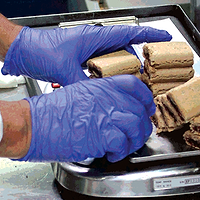The Need for Foodservice Employee Allergen Training

In any given industry, it’s only a matter of time before issues once in the background of best practices take center stage. Restaurants are no different. “Gluten-free” wasn’t a household term until a few short years ago, and even discussions around restaurants serving allergy-friendly menu items remained a backdrop to other issues until the start of 2008.
That means for more than 60 years, the restaurant industry focused on how to best serve customers who, by all accounts, had little or no obstacles when it came to enjoying eating out.
However, in 2008, Westchester County in New York enacted a law that required posters in every commercial kitchen that highlighted the big eight food allergens. The posters outline how restaurant staff should proceed if they were informed that a diner had an allergen issue, and how back-of-house staff can best prevent the cross-contamination of menu items and ingredients.
Since the law was passed, similar state and municipal mandates have followed suit—from Minnesota to Rhode Island—in an effort to further protect the health and lives of American diners.
To date, it is estimated that some 15 million Americans have food allergies, according to Food Allergy Research & Education (FARE), with the number of food allergies among children growing approximately 50 percent between 1997 and 2011. Additionally, more than 17 million Europeans have a food allergy.
The top eight food allergens—milk, eggs, peanuts, tree nuts, wheat, soy, fish and shellfish—account for 90 percent of all allergic reactions.
In recent years, we’ve all read proliferating headlines about restaurant patrons having an allergic reaction after being served menu items contaminated with the cause of the reaction. While a majority of cases have not been fatal, they can be life-threatening if not properly and promptly treated. According to a 2007 study by the Food Allergy and Anaphylaxis Network (FAAN), there were 63 food allergy-related fatalities between 1996 and 2006, with half involving restaurants.
These numbers may seem low; however, it is likely they have increased over the past 8 years due to the rise in both consumer visits to restaurants and in the number of Americans with food allergies.
Employee Training
While much has been done to educate kitchen and waitstaff on safe food-handling practices, continued instruction in this area could be the difference between life or death for one of your patrons. There is a big difference between food items to which people are intolerant, such as gluten, and items that result in an allergic reaction. Allergic reactions are often more severe; once every 3 minutes, someone requires medical attention—in some cases, hospitalization, which equates to more than 200,000 emergency room visits per year—and may die due to an allergic reaction. Meanwhile, a person with a gluten intolerance may experience mild to extreme discomfort if introduced to gluten, yet would unlikely be in a fight-for-life situation.
This is why food allergy and gluten-free training is an important component of any foodservice operation.
Recent legal actions brought on behalf of those with food allergies have also raised consciousness in the food-service industry about the importance of training foodservice staff.
In December 2012, the U.S. Department of Justice entered into an agreement with the housing and dining services of a large private university that has implications for the foodservice industry as a whole. The agreement ensures that the school’s students with celiac disease and other food allergies can fully and equally enjoy the university’s foodservices in compliance with the Americans with Disabilities Act.1 Additionally, a 2013 lawsuit was filed against the city of Sacramento, CA, by the parents of a 13-year-old girl who died from a peanut allergy while at a city-run camp. The girl was given a Rice Krispies® treat that contained peanut butter and developed symptoms of anaphylaxis, becoming nauseated and developing extreme breathing difficulty, as a result.
As a consequence of these lawsuits—and several others—severe food allergies may now be considered a disability under the Americans with Disabilities Act.
This makes training unavoidable and good training that provides lasting retention of the material even more essential. It isn’t enough to say that your staff members have completed a food allergen certification course. Best practices demand that staff be trained in a manner that will ensure the long-term retention of important points that make the difference between avoidable mistakes and turning patrons with food allergies into loyal repeat customers.
Many certification programs require the annual retraining of foodservice staff to increase retention. This is because repetition is shown to increase learning. This is why well-designed training courses make a point of reiterating critical details throughout the teaching process.
But it isn’t as simple as picking the most significant points and repeating them over and over. Research into adult learning shows that specific repetition methods play crucial roles in creating lasting knowledge and understanding.
The American Society for Training and Development has also reported that those who invest more in training have a 37 percent higher gross profit per employee. Other studies, such as one by Workforce™, have found that companies that spend an average of $273 on employee training have a 7 percent voluntary employee turnover rate. The decrease in voluntary turnover contributes an overall cost savings to the foodservice provider, because employees are engaged and feel better prepared to handle the demands of their jobs. They feel invested and are less likely to leave because they’re loyal to the brand.
Therefore, the investment in employee training and certification courses becomes a win-win for your customers, your staff and your operation overall.
Current Training Programs
In January 2011, the National Restaurant Association (NRA), in collaboration with the Massachusetts Restaurant Association, answered the call to comply with a 2009 law that gave restaurants until February 1, 2011, to have at least one staff person trained in a state health department-recognized training program. Each foodservice establishment needed to have an on-staff food protection manager who has been certified. The program consisted of an informational 30-minute video followed by a short exam. FAAN supplied the video to the State of Massachusetts and it is still in use today.
Three years ago, my company, MenuTrinfo®, introduced AllerTrain™, a food safety course designed to teach foodservice operators and staff how to handle customers with food allergy or gluten intolerances. This certification course teaches staff how to identify allergic reactions, emergency procedures and Standard Operating Procedures in response to an allergen-sensitive diner. We also recently added Master Trainer™ to our suite of offerings as an educational course for food safety trainers to keep them current on the latest food safety practices.
The NRA also created a ServSafe® Allergens program in 2013 that is an online option for hourly foodservice employees. The program defines food allergies and teaches foodservice employees how to recognize the symptoms of someone having an allergic reaction. It trains both front- and back-of-house employees.
The programs such as the ones provided by ServSafe and the National Environmental Health Association have done a wonderful job of cultivating food safety and provide an extra layer of allergen training.
The importance of this particular training has to do with the level of service that people with food allergies and special diets need. The number of diners with food allergies in the U.S. has increased, and it’s our job to ensure that their lives and health are protected.
Because people travel, they have to eat out, which is why it’s more important than ever that we, as an industry, continue to learn and implement best practices. There is no other solution than continued training and education.
Jules Shepard, author of The First Year of Celiac Disease and Living Gluten-Free, summed it up best, “It is important for restaurants that want to serve a wider audience to invest in training for the front and back of the house. Building loyalty and capturing additional revenue may be the motivator for a restaurateur, but those operators that educate themselves and their staff to serve this client safely will see the results clearly.”
Training Best Practices
We have talked a lot about the importance of food safety training, and below are several best practices we believe will help operators flip the fear in regard to serving diners with special needs. As an industry, it is up to us to work out the solutions to these challenges.
We recommend these six best practices when it comes to employee training and back-of-house operations to further protect your staff and your brand.
1. Print your recipes and make them available to staff so everyone knows what ingredients are in your dishes, and what needs to be changed to accommodate diners with allergies. Make sure everyone knows the alternate names for the big eight allergens. A list of alternate names for allergen ingredients, developed by FARE, can be found at www.foodallergy.org/document.doc?id=133.
2. Create a policy for both your front- and back-of-house employees. This policy should reflect how each person should handle and react to questions about allergen-free menu items. Policies also should include the resources you use in your restaurant to handle special dietary needs and how your staff handles customers with special requests.
3. Have a disclaimer up in your restaurant that explains to customers the need to alert their server if someone has a food allergy. Post your disclaimer on your website, paper menus and menu boards, and make it easy to see. Your disclaimer should let everyone know the efforts and the lengths to which your restaurant has gone to accommodate diners with special dietary needs. For example, if you own a pizzeria, include the fact that certain dishes are made in locations and on surfaces where no flour is used.
4. Wipe down every surface first with soapy water and a clean cloth. Afterward, use sanitized cloths to wipe the surfaces again.
5. Identify special dietary meals, such as allergen-free dishes, and highlight them on your menus and menu boards. You can do this through the use of a special icon next to those dishes.
6. Use specially marked tools and plates in the kitchen that are reserved for allergen-free dishes. I was at the NRA Hotel-Motel Show in Chicago and saw some great tools that can go into food that are purple. Purple is the color in our kitchen that now identifies allergy-friendly food items. So whether it is a frill pick, purple pick, double plate or green plate, use something to identify how that meal leaves the line and makes it to the table safely and intact.
Overall, restaurant operators need to understand that in today’s technologically savvy, convenience-focused, fast-paced society, they have abundant resources at their fingertips. There are no more excuses.
We are not talking about random food safety training. We are talking about training that does and will continue to save lives. It is worth the investment of your time and money. By having certifications behind your name, you gain the trust of your patrons, as well as that of their friends and family, and build a high reputation for the level of service you provide to your customers. Remember to take your training to heart and never do anything pertaining to food allergies, intolerances or celiac disease at less than 100 percent. Give it your all and put yourself a mile ahead of your competition.
Betsy Craig is the CEO and founder of MenuTrinfo® LLC, which is dedicated to protecting lives and promoting brands by proactively building nutritional products for restaurant kitchens with confidence. MenuTrinfo has become a national nutritional partner for the NRA and FARE.
References
1. www.ada.gov/q&a_lesley_university.htm.
Looking for a reprint of this article?
From high-res PDFs to custom plaques, order your copy today!








